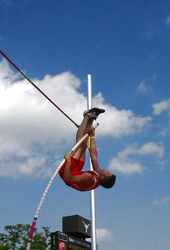Sport and Technology
From the sports shoe to the swimsuit and the tennis racket to the football, sports technologists have applied their ingenuity, creativity and expertise to develop better and safer equipment in the quest for sporting excellence. The outcome has been: enhanced performance; better, safer and more effective sports equipment; precision measurement of performance; a multiplicity of ways to experience sporting events anywhere and at any time.

(Photo: Hunter Peress)
Novel and groundbreaking sports technologies are protected under the intellectual property (IP) system by patents. Patents protect new inventions and facilitate the diffusion of technology. They prevent the unauthorized use of an invention for the life of the patent – usually 20 years. This provides an incentive to innovation by giving inventors the chance to recoup their investment in developing the invention and earn a financial reward. In return for the exclusive right to exploit the invention, the inventor is obliged to disclose the details, adding to the public stock of knowledge and providing the basis for further innovation. After the period of protection ends, anyone is free to use the technology.
Patents encourage businesses to invest in developing and commercializing new and improved products. They help to stimulate technological progress, because all patent applications are published. And as these products are commercialized, they become widely available to sports enthusiasts in the marketplace.
Patents
- provide an incentive to innovate
- recognize and reward inventors
- encourage investment in research and development
- expand the body of public knowledge
This cycle of innovation, promoted by patents, has resulted in the progressive replacement of the natural materials (wood, twine, gut, rubber) used to make early sports equipment by a wide range of highly sophisticated man-made materials including alloys and polymers. Stronger and lighter sports equipment made with these high-tech materials has enabled sportsmen and women across the globe to reach new heights of achievement while minimizing the risk of injury, and has helped sports enthusiasts everywhere to enhance their performance. Other improvements range from sleeker and faster surfboards to more comfortable gloves with an anti-slip lining for football goal-keepers.
Other patented sports and training equipment includes bobsleds, aquatic wheelchairs, starting block assemblies, stop-watches, golf clubs and gym equipment. Sports drinks, and muscle-building and nutritional supplements, are other examples of sports patents.

Footwork Training System and Method: A system
and method for evaluating an activity includes an
article of clothing provided with a sensor capable
of detecting the impact of the article of clothing,
such as a shoe, on a surface.
On track with patents
Thanks to the patent system:
- manufacturers of sports equipment gain financially from innovation, which in turn boosts the strength and vitality of the industry for the benefit of the economy as a whole;
- researchers have access to a mine of technical information, which they can use to inspire innovation and improvements to existing products;
- sportsmen and women around the world benefit from innovations in sports equipment to enhance their performance, minimize injury and promote fast recovery when injured;
- the general public benefits from a wider range of high-quality sporting goods.
Protecting patent rights internationally
Like other IP rights, patents are territorial – they have legal effect only in the country or region in which they are granted. Seeking patent protection in multiple countries can, therefore, be time-consuming and expensive. WIPO’s Patent Cooperation Treaty (PCT) enables inventors to file a single “international” application to set in motion the process of obtaining patent protection in multiple countries.